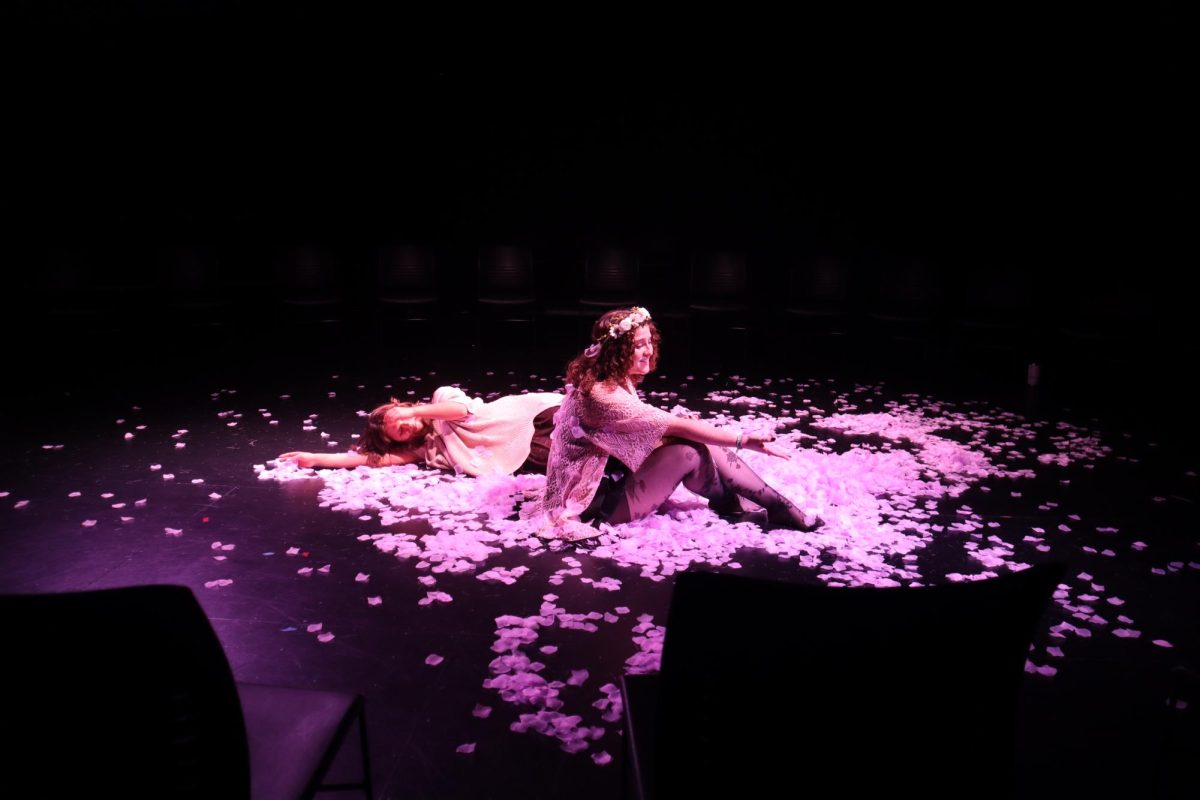Loss is never easy, but the Performance Studies area of Villanova University’s Communication Department has found a unique and artistic way to process it.
Students performed An Inventory of Losses on Thursday, Oct. 19 and Friday, Oct. 20, in the Communication Department Studio in Garey Hall. Directed by Dr. Evan Schares, this was the Performance Studies area’s first production of the year.
The performance of An Inventory of Losses was adapted from Judith Schalansky’s book of the same name. First released in 2018 in Germany and published in the United States in 2020, the story dealt with themes of memory, loss and disappearance. Schares, an Assistant Professor of Performance Studies at Villanova, was inspired to adapt Schalansky’s book by a family history of Alzheimer’s and dementia. Thus, he wished to interpret and portray the societal impacts of various forms of memory loss onstage.
“That was really one of the driving anxieties of the show’s creation,” Schares said. “This deeply, personally felt loss. Literally, memory loss. That really was the driving inspiration and driving anxiety to my approach to Schalansky’s An Inventory of Losses. I really wanted to creatively explore or question loss, memory slippages and objects that we have, and I thought that source text really allowed me to do that.”
The show featured six performers: Elizabeth Weiss, Grace Dwyer, Olivia Hansen, Bianca Brucker, Julianna Bibbo and Zoë Magee, a sophomore Communication major specializing in Performance Studies and minoring in Theatre. An Inventory of Losses was Magee’s first performance while at Villanova. She found her involvement in the show to be a very fun experience, and she likes that the Performance Studies area “shows off Villanova’s creative side.”
“I have such a fun time doing it, especially when we can do projects like this,” Magee said.
Although Schares was the director of the production, the cast and crew collaborated frequently. According to Magee, everyone had opportunities to try different things and change any aspects that were not working during rehearsals.
“Whenever we practiced, no performance was the same,” Magee said. “We were always changing how we wanted to say this certain line or chang[ing] the choreography because we didn’t really like it at the time.”
“One of my strengths in working with student creatives is to allow them to have a voice in the thing that ultimately goes up,” Schares said. “I feel like the best directors for the stage are ones that work collaboratively with the ensemble and with the cast, and that’s the practice that I bring to the stage.”
While preparing for An Inventory of Losses, the cast and crew familiarized themselves with the space of the Communication Department Studio. Being a black box theater, the studio provided a very small, intimate space between performers and the audience. There were no microphones, no elaborate sets and only a handful of props. Because of this, performers had to approach this space much differently than more traditional theaters.
For Magee, this intimate space meant getting used to the close proximity of the audience.
“With a stage, you can’t really see anybody because you’re higher up, and it’s dark out there because the lights are shining on you,” Magee said. “The lights aren’t shining on the audience, so you can get really lost in the scene. I personally like [that] because it gets me into my zone, whereas [in] the black box theater, eye contact with one single person can throw somebody off.”
Having a background in black box theater, Schares thought of the space as “small but mighty.”
“Any sort of space-based limitations are strengths, actually,” Schares said. “Our audience set-up changes for every single show. [There are] unlimited possible configurations of what we can do in that space, so that’s a strength.
One of the unique aspects of Villanova’s adaptation of An Inventory of Losses was that it was not a complete adaptation of Schalansky’s entire book. The runtime of the performance was approximately 40 minutes, so not all of the story’s passages were performed. Instead, Schares was responsible for narrowing down which of the book’s passages would be performed and deciding how they would flow from one to the next while still maintaining the central theme of the full, unabridged story.
“I tried to archive the loss that Schalansky had already [invented],” Schares said. “I tried to archive that on the stage in ways that I felt would tell a story. I wanted them to be very distinct but still relate to each other in some way, and I feel like the texts that I ended up choosing from Schalansky’s inventory of loss all, in some way, address the violence of human modernity, environmental catastrophe and how cultures, in all of their various corners, are left to reckon with this loss that we’re all experiencing in really different ways.”
As a result, the performance was divided into five distinct sections: “The Island of Tuanaki,” “The Empire of Songhai,” “The Songs of Sappho,” “The Last Caspian Tigers” and “Kinau.” Each of these sections approached loss in different ways, featuring distinct time periods and characters. While the theme of loss was apparent throughout the five sections, Schares believed that audience members had the opportunity to find their own messages in the performance, and everyone left thinking something different.
“I think that the beauty of the story told is that it changes every time you try to think of what the show is,” Schares said. “I’m not really sure what stories people walked away with, but I hope that the audience can see the connection between all of the loss that is occurring across our various different communities and interiors.”







